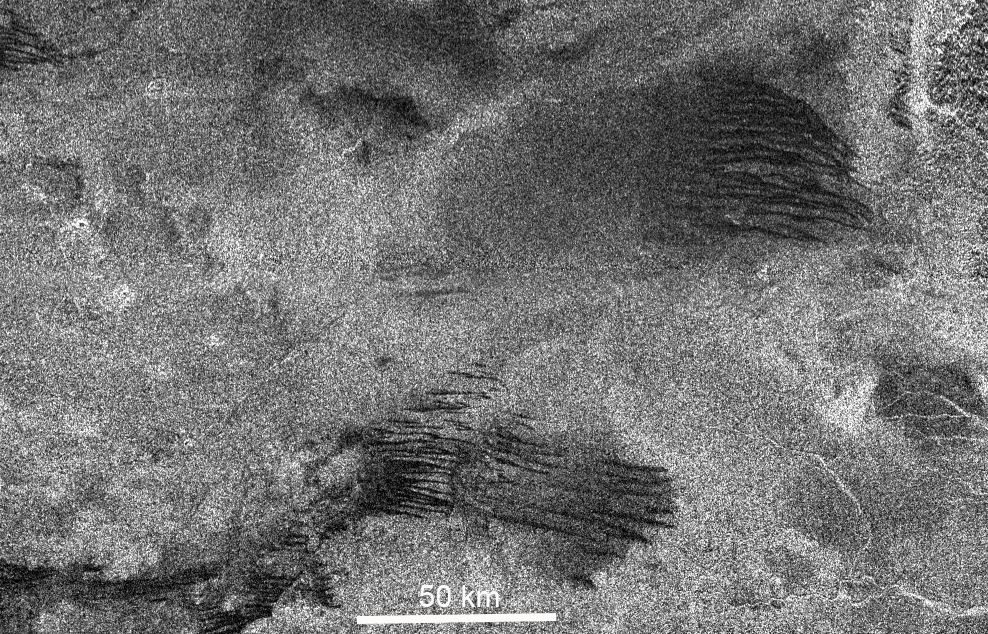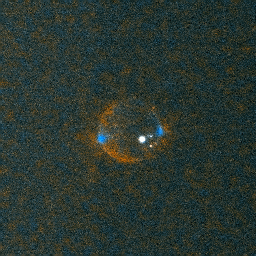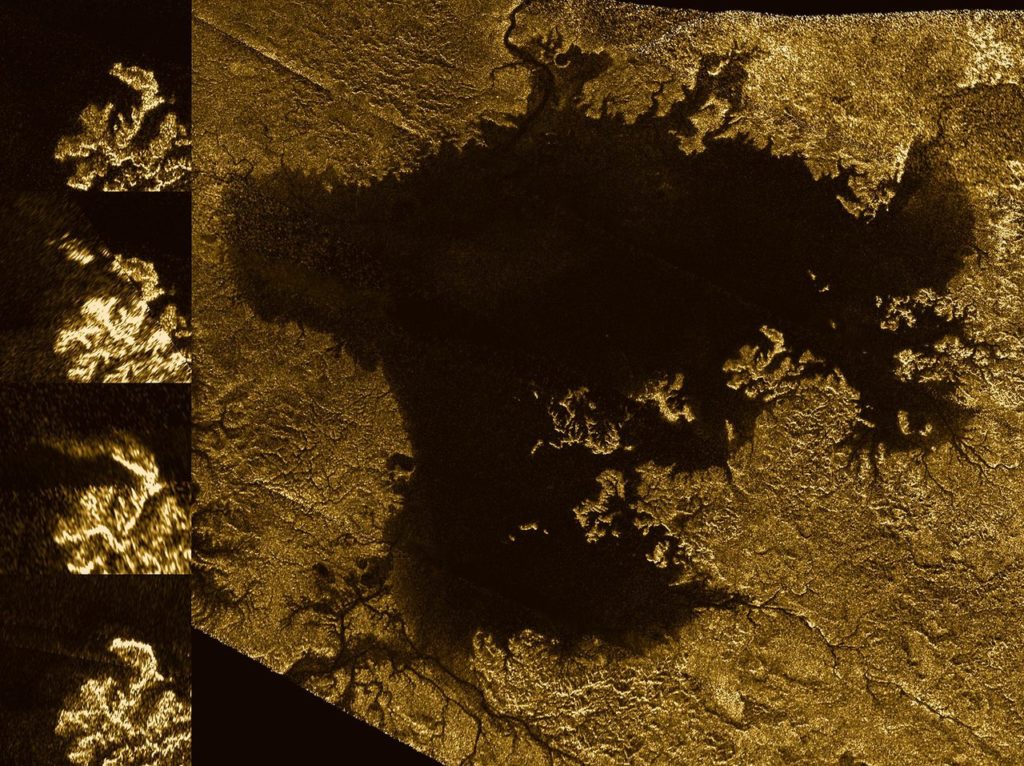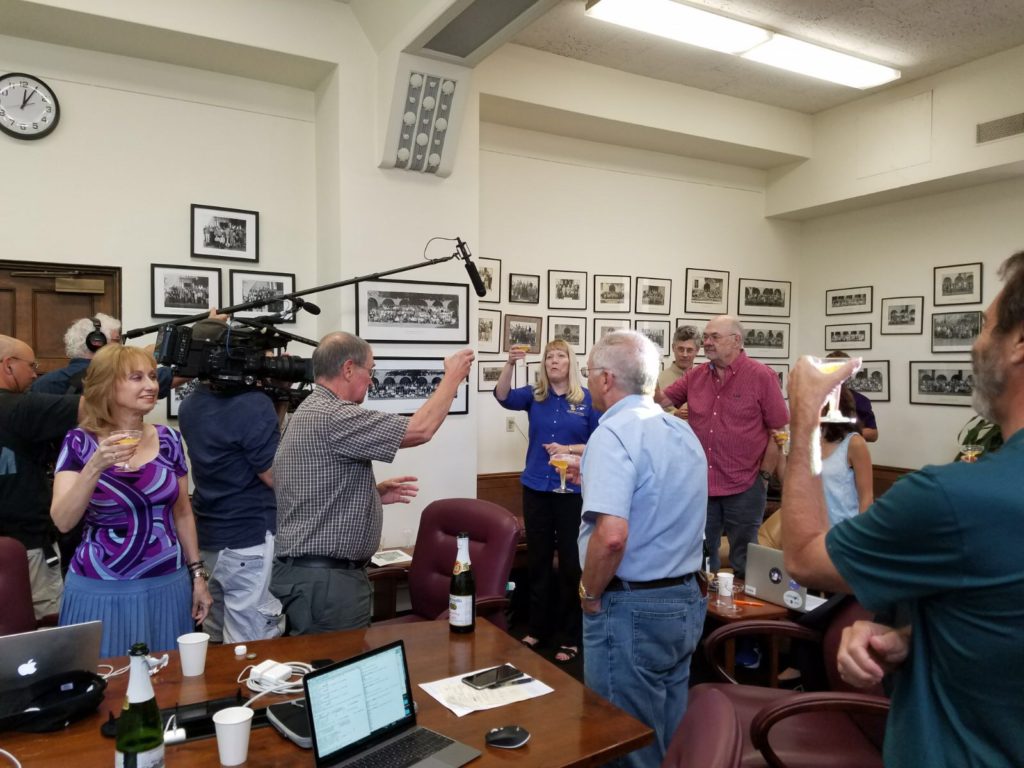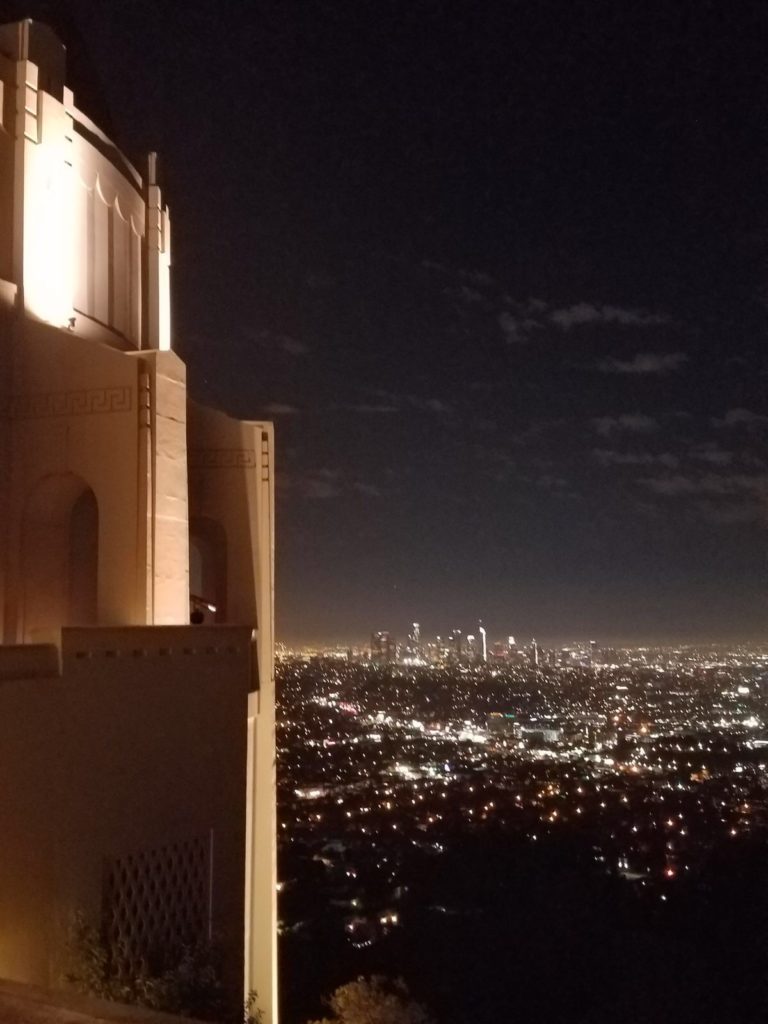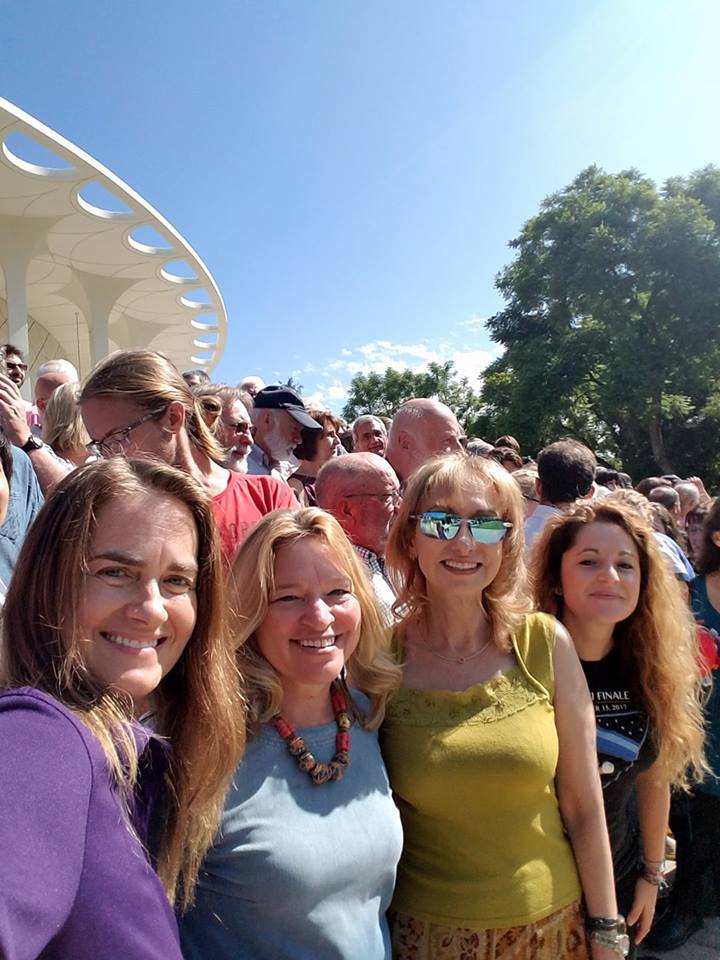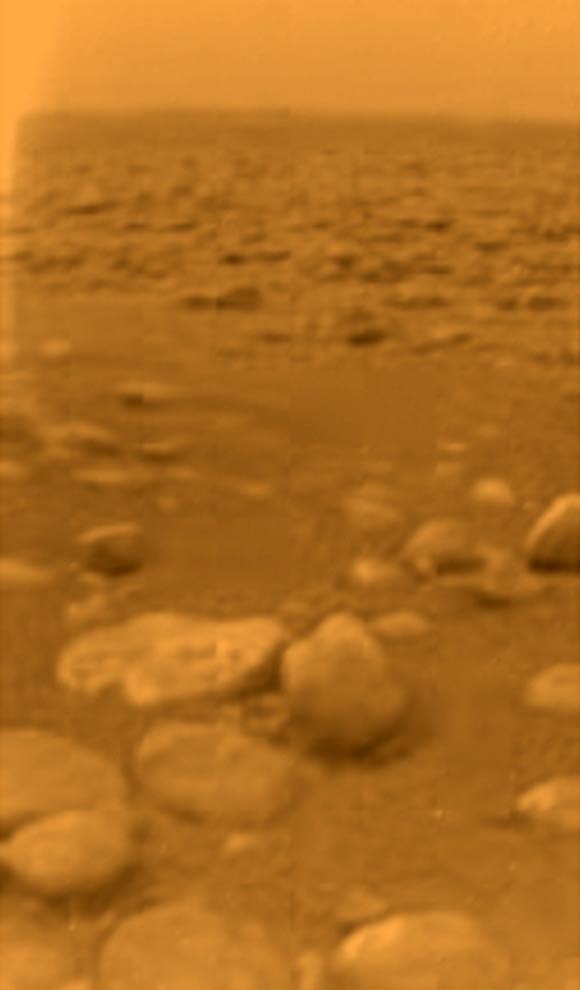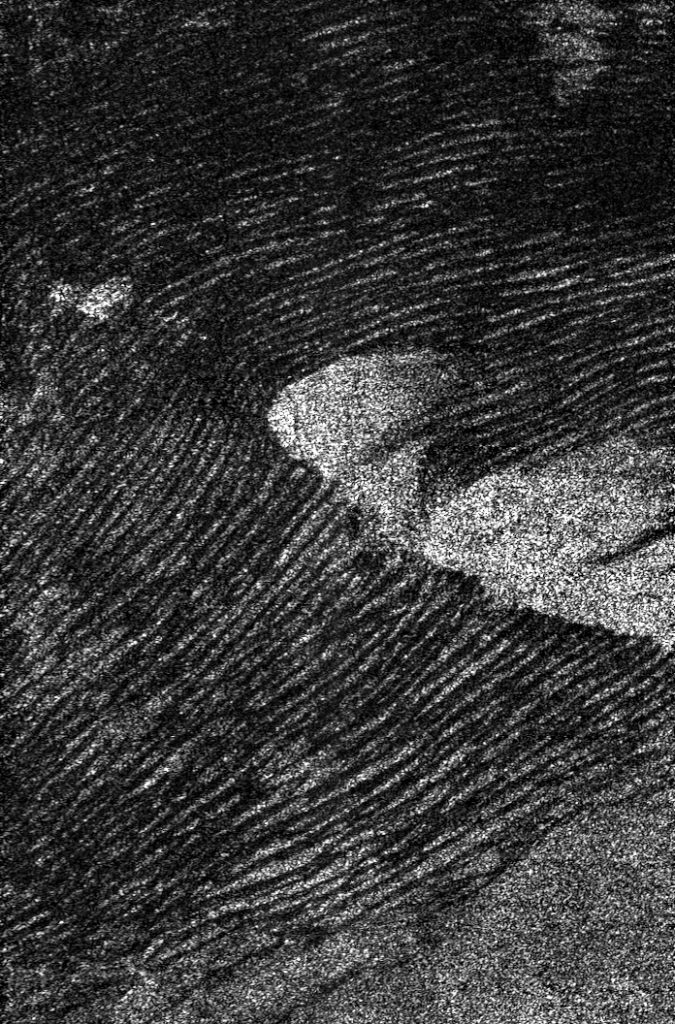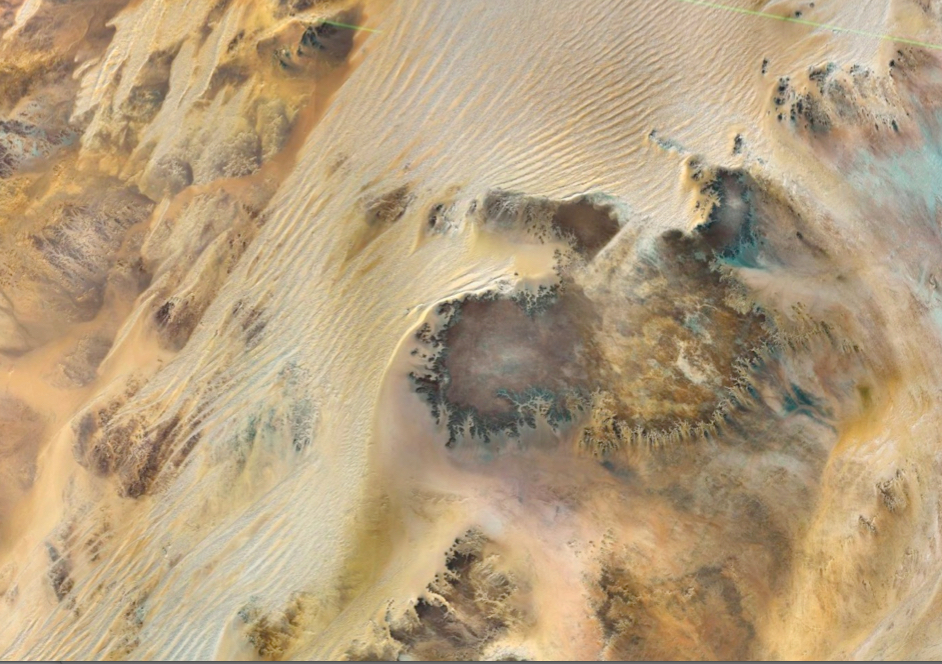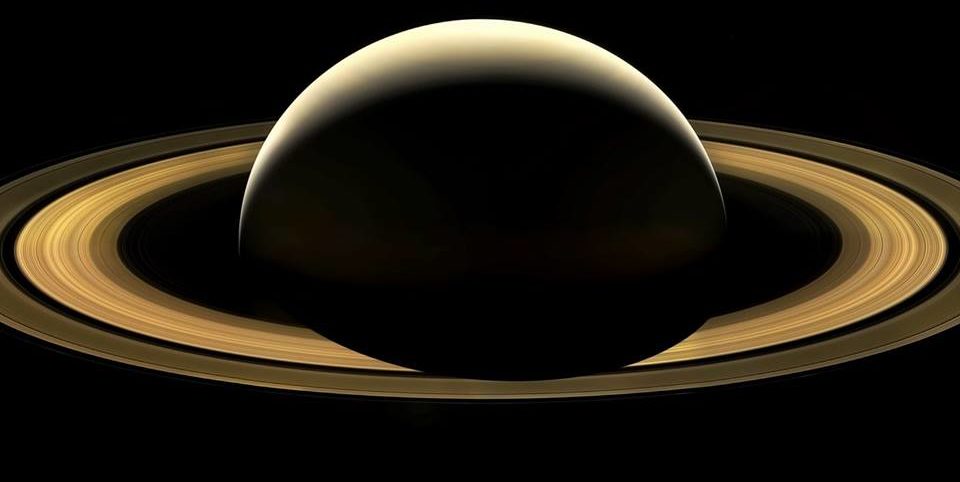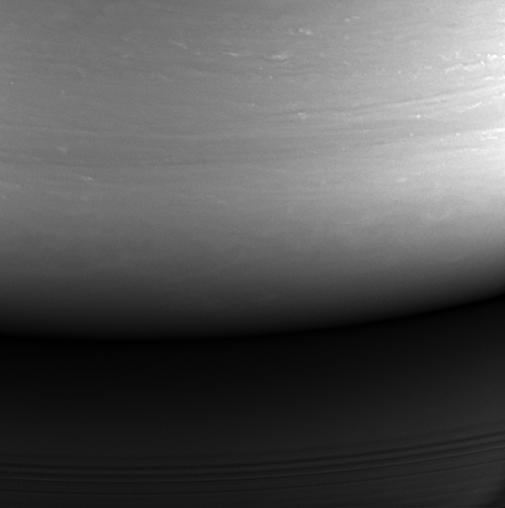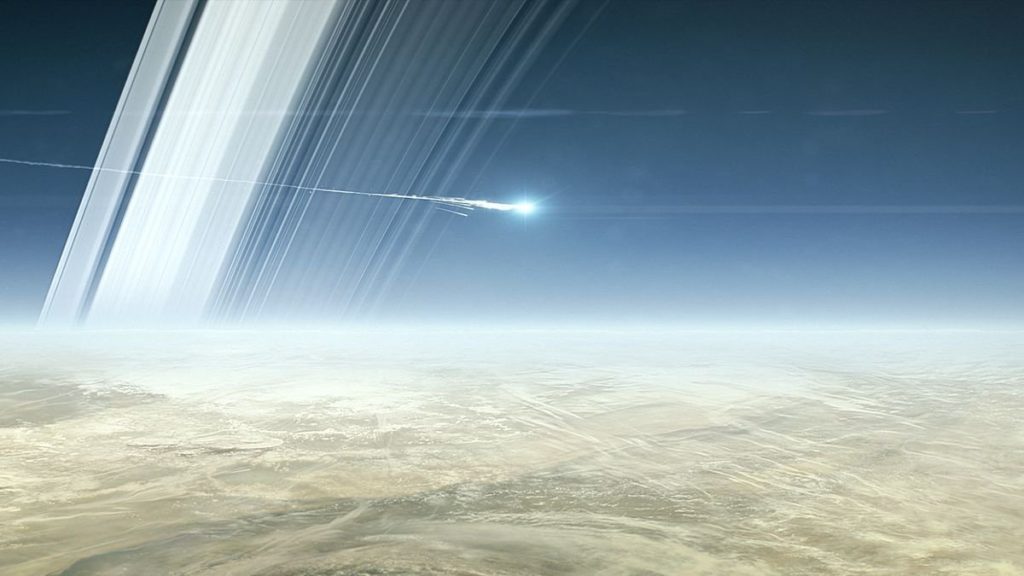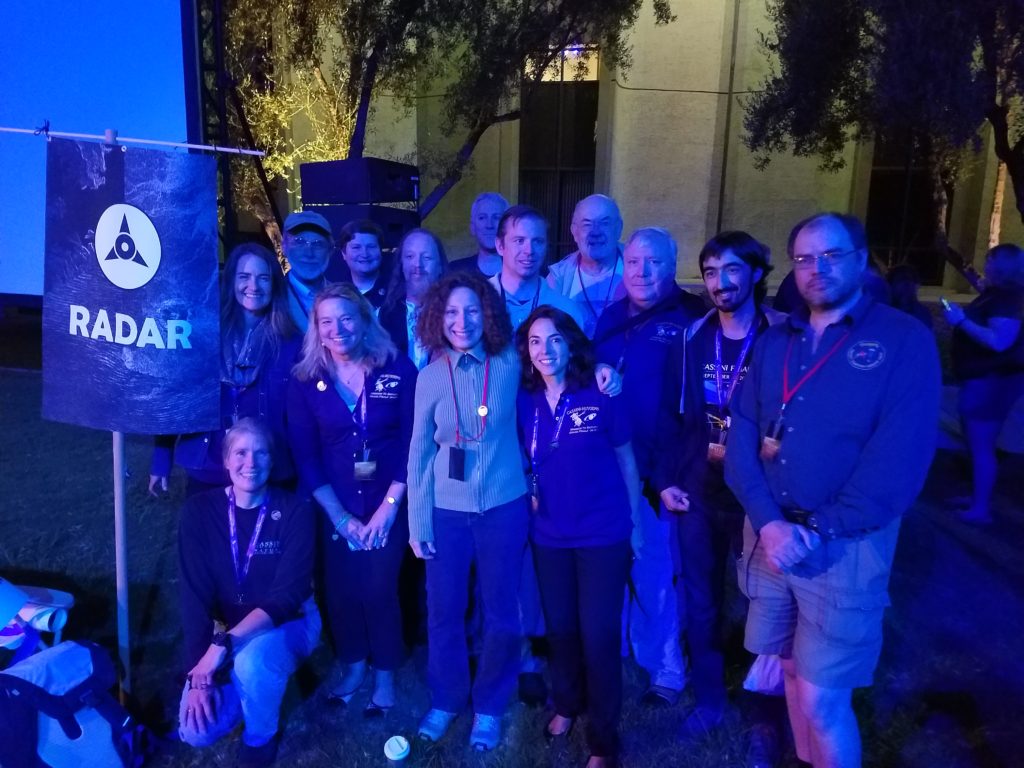Jani Radebaugh is a professor of planetary science at Brigham Young University. After completing her PhD at the University of Arizona working with images of Jupiter’s moon Io from the Galileo spacecraft, she has been researching Saturn’s moon Titan using images from the Cassini-Huygens spacecraft and lander. What follows are Jani’s day-by-day thoughts as the Cassini mission came to a close and the spacecraft burned up in Saturn’s atmosphere. You can read more about Jani’s adventures here and follow her future endeavours on Instagram and Twitter.
10 September 2017:
As I depart for Pasadena to witness the end of the Cassini mission and I think back to my first concrete memory involving RADAR images twelve years ago, I have that disorienting, yet somehow vaguely comforting, feeling that no time has passed at all. That somehow, nothing has changed – and yet, everything has. I remember sitting in a dark room at the University of Arizona’s Lunar and Planetary Laboratory, surrounded by giants in planetary science. All of us were gazing at a screen filled with an unfamiliar kind of image, a greyscale, pixelated rendition of the surface that is characteristic of Synthetic Aperture RADAR (SAR), an image of an even more unfamiliar landscape. It was February 2005, and we were looking at the newly obtained SAR image from the third Cassini flyby of the moon Titan, just north of the Xanadu terrain. Drawing our gaze were long, arcing, regularly spaced, dark lines that scraped across the surface like “cat scratches”, covering everything beneath them, right down to their tenuous, feathery ends. None in the room dared venture an explanation. But planetary surface guru Vic Baker boldly said, “Those look like draa.” (Like what??) “You know, the giant linear dunes of Arabia or Africa, the big deserts of Earth.” My experience with dunes to this point had been briefly, rapidly scrambling up the blood red climbing sands of the canyons of Lake Powell, bare feet sliding and burning up the sloping surfaces until we had to plunge into the deep green water to cool off. Or wandering mystically with my planetary class across a high, bright pile with bafflingly regular crests with the volcanic maar craters of the Pinacates on our right and the estuary of the Gulf of California in Mexico on our left. Or gazing at the towering cross sections of their solidified, fossilized forms, remnants from a deep age desert, the Jurassic sandstones of Capitol Reef. But I’d never heard about giant dunes before, never known about the vast, uninterrupted deserts of Africa, Arabia and Australia that allow their dunes to grow long and large. And now when I think back to this moment, I am transported across Egypt, Tunisia, Namibia, the United Arab Emirates, and Australia’s red center, the deep and remote and endless deserts of Earth – all places with giant, beautiful linear dunes I have since laid foot upon. All because of Cassini.
11 September 2017:
I had to think carefully to remember that Cassini has been in space the entire time I’ve been in planetary science. It launched in 1997, when I was studying geology and solar system volcanoes at Brigham Young University. I was barely aware of this event, being busy scrambling over granites and avoiding rattlesnakes, blissfully embracing the world of geology fieldwork. But I do remember watching in rapt awe when the little Pathfinder robotic geologist landed on the surface of Mars that summer. Four years later I was a planetary sciences student at the University of Arizona, poring over wildly colored Galileo and Voyager images of the surface of Io, impossible in yellows, greens, reds and blacks from sulfur and active lavas. Contrasting Io with what I knew of the Moon, which was starkly beautiful and varied, yet cold and dead, I was in complete awe of this distant, living place. I got to help plan and analyze the images coming down from Galileo, which utterly spoiled me for being involved in active missions and for being the first to see those corners of the solar system. Cassini used Jupiter to slingshot it to Saturn, and while it was there it tested its array of instruments at the Jupiter system. Because the high gain antenna never opened on Galileo, data had to trickle in on the low gain antenna, and every bit of precious data was analyzed to the hilt. I might still be able to recall every picture taken of Io. When Cassini zipped by Jupiter, it took pictures like paparazzi and sent it gushing back to Earth as in a firehose. The data were distant images obtained while Io was in the dark, so all the light we observed came from Io’s volcanoes. We used the light to find out how active, how incandescent, how big and how persistent were the big player volcanoes – Loki, Pele, and Pillan. This was a treasure trove of data, and it revealed much about these gushing, boiling lakes of lava and giant lava flows. And this sent me on a path to the lava lakes of the world – to Hawaii, Ethiopia, and Vanuatu – to better understand these complex beasts up close. Once again, Cassini sent me on a slingshot to the far corners of the Earth.
12 September 2017:
Today was a day of “lasts” for Cassini. It was the last time a command was sent to initiate the last RADAR sequence, the last time Cassini flew past Titan, the last time RADAR data was obtained, and it was the last time the spacecraft would head out away from Saturn. Maybe the most heartbreaking, it was the last time the RADAR instrument received a command, and it was to shut down the instrument for good. We had our last RADAR team meeting before the end of the mission, and as usual, we discussed recent results, the exciting new work people have been doing on the science of Titan, Saturn, the rings, and satellites. We heard some jaw-dropping things that are still for our ears only, until we can kick them around more and amass our evidence. But we also had time for reflections on our origins as an instrument, a mission and a team.
I loved being surrounded by so many greats in the field, all telling their stories of how they remember things. There was a summary talk of the state of the liquids on Titan’s surface from Jonathan Lunine, and it was to a room filled with scientists and paparazzi (ok, media…). I love to hear Jonathan talk about any topic, because of his ability to engage at all levels, to pack it with pure and new science, and to infuse things with hope and cool. As a grad student wrapping up my thesis, I targeted him as a professor to be a teaching assistant (TA) for, just so that I could listen to him speak to a class a few days a week. I must have done ok as a TA, because when I approached him to work on Cassini, which had just arrived at Saturn the year previous, he remembered and brought me on to help two French students there for the summer of 2005 to work on the geology from the first and third Titan flybys. And then my foot was in the door for Cassini RADAR. We of the young generation all spoke today of how grateful we are to have been a part of a warm, welcoming and nurturing team, which is not a given in our field. There were toasts all around (Martinellis…), and project manager Linda Spilker came in to tell us that Titan’s gravity had just given Cassini its final “goodbye kiss”. Later, we celebrated at Griffith Observatory, all of us feeling the weight and nudge of the history of the place propelling us towards the events at week’s end. And while we were there, just a few hours ago, Cassini turned around from apoapsis, the most distant part of its orbit, and headed back towards Saturn – for the last time.
13 September 2017:
In contrast to yesterday, today was all about the “firsts” of Cassini. All of us, around 120 scientists, gathered in the large Baxter lecture hall of Caltech for the Project Science Group (PSG) Meeting. We heard warm thoughts from project and NASA leaders, listened to the creative Cassini singers and were even serenaded remotely by Tommy Shaw of Styx – the finish, of “don’t leave me” was heart rending. We also watched the very first PSG, from 1990, which, with all the suits, big glasses and big hair, was like a 1970s cop TV show… It was really fun to see all the leaders in my field as young, eager and wide-eyed, a little like us modern Cassini youngsters. And as we walked out for a group picture, I was struck by how diverse the field has become since those days.
My first tears of the week came when engineer Julie Webster delivered her typically matter-of-fact description of the details of the latest flyby – the last flyby of Titan – and as she sat down, she got a standing ovation from the crowd for all of her work as gatekeeper for Cassini over the years. She threaded her way back past people and film cameras to the podium and said,
“You know, it’s taken me ten years to realize this mission is all about the science [and not just spacecraft operations/safety]. I hope you got what you wanted. And I want you to know, next time, I will be there for the science.” This last phrase was prescient, and sunk in for each of us individually. My thoughts turned constantly towards Titan today, as the last flyby data started downlinking this evening. Another first for me from Cassini occurred when Huygens landed on Titan’s surface in early 2005. At Alfred McEwen’s PIRL lab at LPL, we waited anxiously for the first images to come back to Earth. What appeared on my screen seemed like a mistake – I must have been looking at Mars. Through a reddish, hazy atmosphere were rounded cobbles and sand in a vast, dry riverbed. Such a complex landscape could not have been on cold, distant Titan. But it finally dawned on me that this must be the new reality, that rainfall, rivers and wind had acted on Titan’s surface, which was shaped into distinctly Earth-like landscapes. And I was dying to see more.
14 September 2017:
The first time we saw Titan from Cassini, it became immediately apparent this was an Earth-like landscape. There were river valleys, sharp and eroded mountains, vast fields of sand dunes, and lakes and seas – of methane. Being a newly minted geologist and planetary scientist, I felt naturally drawn to similar landscapes on Earth, to study them in the hopes of learning something I could apply to Titan. The large megadunes had me completely awestruck; I had never seen anything like them. On Titan, they are about half a mile wide, dozens to hundreds of miles long, and have flat, non-sandy regions between them. It turns out they are identical in size and shape to the
On Titan, they are about half a mile wide, dozens to hundreds of miles long, and have flat, non-sandy regions between them. It turns out they are identical in size and shape to the megadunes of Africa, Australia and Arabia, and I made my plans to set foot on these analogues place by place. A willing, and enabling, accomplice in this field work was Ralph Lorenz, who allowed me to drive us to a pinpoint on Google Earth in the middle of the Simpson Desert, Australia, where two dunes worked their way through a mountain obstacle, just as I’d seen in a Titan RADAR image. The Red Center is spectacularly empty, flat and red, but the dunes were small and covered in vegetation – they are fossils of an active desert – so we set our sights on Africa. We found ourselves on thin, feathery dunes near Cairo, exact matches to the “cat scratches” of the third Titan flyby, and dipped our toes into the edge of the Great Sand Sea on the border with Libya. We made it to the giant, red dunes of Namibia, massive towers of sand abutting a patient ephemeral river, and to the buff dunes rising above the salt pans of the Rub al Khali in the United Arab Emirates. Each time, different Cassini colleagues came along and offered their support and perspective, and each time we carried different instruments. I also brought bright, capable students who worked tirelessly, thought creatively and helped me see things I would not. All of us go to the desert to figure out the megadune puzzle: why they are there, and how and where they are moving, and we translate that to Titan. We are making headway – but I may need to set foot on every mega dune on Earth before I think we’ve finished.
15 September 2017:
At 4:55 am this morning, many of the carefully placed white chairs on the dark Caltech lawn sat empty as team members stood piled together and embracing, gazing up at giant screens showing mission control at JPL and the imminent descent of Cassini into Saturn. A jagged green line glided across the screen showing the Deep Space Network signal tracking, with a sharp peak in the center that was the voice of Cassini. We all understood what it meant when the peak slowly dropped – then sprung up again briefly – then dropped again to flat. And there was silence – across the lawn, in the mission control room, no one ready to cross over the threshold to a solar system without Cassini. A grateful cheer slowly rippled across the crowd, with some heartfelt words from Earl Maize in mission control, and then it was over. Cassini was in Saturn’s embrace. I’ve never seen such a dramatic end to a planetary mission.
Even for Galileo, which similarly crashed into Jupiter, we all felt like it was time, especially given its aging and failing instruments. And I remember feeling that it was no longer hampered by its failed high gain antenna. But Cassini was robust to the end, delivering an array of stunning new Titan data, a gorgeous Enceladus setting behind Saturn, movement in the rings and ring moons, and data we’ve not processed yet about Saturn’s atmospheric makeup. It gushed images and data down into the arms of hundreds of bright scientists – and that is all now over. I’ve been struck by how personal this mission is (was!) for everyone involved, from scientists like me, to engineers and mission controllers, to team leads. As with every other endeavor we undertake as a species, this was ultimately a human one, and it affected each of us in deeply emotional ways. Being a scientist at a university I have the luxury of choosing what projects to work on, so I can continue to work on Io even after Galileo is over, and Titan after Cassini has ended. But today I started to internalize the loss we share as a community as many others move on to other projects. JPL will shutter Cassini operations beginning today, and many people will physically move to other offices or jobs. Trina Ray of operations likens missions to neighborhoods, and the end of a giant mission like Cassini means the disintegration of the neighborhood. Thankfully, the field is small, and our paths loop around and cross back over each other in ways we don’t predict. And we work hard at seeing those we love. But now it is the start of a new era, one without a bus-sized, capable spacecraft in orbit around Saturn. We will no longer get those regular gifts, as Trina says, those surprises from Cassini showing us new storms in Saturn, new shepherd moons in the rings, and new landscapes on devastatingly beautiful, captivating Titan. Saturn and its moons are suddenly like Neptune and Uranus – distant, remote places where we are simply no longer there. And we wait. Ten years. Twenty. – When?
![]() This work is licensed under a Creative Commons Attribution-NonCommercial-ShareAlike 4.0 International License.
This work is licensed under a Creative Commons Attribution-NonCommercial-ShareAlike 4.0 International License.

